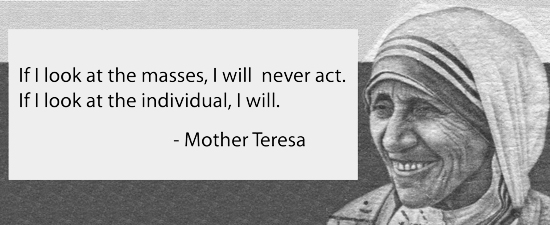What is the best way to influence stakeholders and generate change? Different approaches have their strengths. Learning when and how each approach should be used to the best effect may be the key to creating impact.
Mother Teresa once said: “If I look at the masses, I will never act. If I look at the individual, I will.”
It’s not just Mother Teresa who feels this way. There is even a name for this psychological phenomenon where we feel more compelled to act when one person is suffering than when many are suffering: the Identifiable Victim Effect. And if even Mother Teresa - a saint (!) – was left unmoved or uncompelled to act when we speak of large numbers, there must be something powerful about this phenomenon.
When we hear about hundreds of thousands of people suffering, it is so hard to comprehend that we end up turning a blind eye. Yet when we hear about the plight of one single person we become more emotionally invested and moved to action. Consider the horrific and heart-wrenching image of three-year-old Aylan Kurdi, or more recently Omran Daqneessh. It is not just that these victims are children, although that may make it particularly painful. The pain is acute because hearing about one single person paints a more personal story that resonates with us.

Psychologist Paul Slovic calls this phenomenon of tuning out mass atrocities ‘psychic numbing’. It could be argued that some of our most pressing health issues are mass atrocities – not as salient as natural disaster or a terrorist attack or genocide, but a chronic, slower-moving mass atrocity.
Which is why it was particularly interesting to hear different views emerge when we asked health and community leaders about how to best help healthy activities gain momentum and spread throughout communities. In our work on Health as a Social Movement, in collaboration with Nef and Nesta, supported by NHS England, we are seeking to understand how good practice among vanguards (new models of care) is best scaled up and spread. How does individual level behaviour change develop into group- or community-level behaviour change? How can these vanguard models of care help amplify their activity to promote wide-scale healthy living?
On the one hand, many people mentioned that the best way to help these practices spread is through evidence, facts, and figures. Yet others had a different opinion and highlighted that personal stories which tap into people’s passions are what make a difference.
So who’s right?
From the discussion above about the identifiable victim effect and psychic numbing, you might guess that I would suggest that sharing personal stories of one particular beneficiary would help to move people to action.
But perhaps the best approach depends on who needs to be influenced.
People in the community, patient groups, or service users may indeed be swayed by personal stories to take up a given behaviour. But when it comes to commissioning decisions, such as which vanguards and vanguard activity to support, the CCGs and other decision-makers may need material to fall back on to justify their ultimate decision taken.
Defensive decision making, according to professor Gerd Gigerenzer in his book Risk Savvy, is when someone does not necessarily select the option which they believe to generate the best outcome, but instead picks the option which is most easily defended should they be asked to justify it. There is always an element of risk when selecting an option – the consequences might be positive, or they might be negative. When the consequences are positive, justifying the course of action is easy. But when the consequences are negative, a justification like “I followed my gut” or “that vanguard seemed to tell a good story about one person who they helped” might not fly.
So when appealing to CCGs and other decision-makers within the Health System, having evidence of impact – through facts and figures – may indeed be an appropriate approach to help support the spread of vanguard activity.
What then is the right approach to help move a new activity from the adoption to the diffusion stage? Perhaps it is a two-pronged approach. On the one hand, vanguards (or indeed any organisation trying to influence behaviour) could highlight one personal story – a story that will help compel people to take action. Alongside this popular appeal, vanguards could back up that personal story with supporting evidence that they are indeed making an impact.
Such a two-pronged approach speaks about both the individual, to appeal to our inner Mother Teresa, and about the masses, to help us justify our decisions to support the adoption and spread of the various health-creating behaviour advocated by the vanguards.

Join the discussion
Comments
Please login to post a comment or reply
Don't have an account? Click here to register.
Great overview Nathalie of an area that I have pondered for years in my own discipline of community-led regeneration. Isn't the best combination where the stories are representative of the evidence?